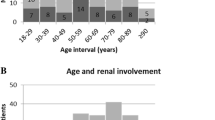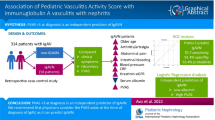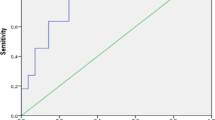Abstract
Objective
Although relatively rare, adult immunoglobulin A vasculitis (IgAV) can lead to severe complications and longer hospitalization, and result in poor prognosis, when compared to childhood IgAV. Hence, early identification and prevention for patients prone to develop systemic involvement are essential. The purpose of this study was to explore the correlations of common serological markers with the development of systemic involvement in adult IgAV.
Methods
A retrospective analysis was performed for adult IgAV patients, who were hospitalized in Wuhan Union Hospital between January 2016 and December 2019. A total of 259 patients were enrolled, and the pre-treatment serological markers were comprehensively assessed.
Results
In the present study, 49.0% and 33.2% of patients developed renal and gastrointestinal (GI) involvement, respectively. Furthermore, the elevated levels of white blood cells count, D-Dimer (D-D), C-reactive protein (CRP) and neutrophil granulocyte ratio (NE%) >60% were significantly associated with GI involvement in the univariate analysis, while the decrease in high density lipoprotein level, and the elevated D-D and CRP levels were significantly associated with renal involvement (P<0.05). Moreover, a prediction model that combined multiple markers was established by performing a logistic regression analysis, and this presented a more favorable value of prediction than the individual serological markers.
Conclusion
The present study suggests that common serological markers have close correlations with systemic involvement in adult IgAV, and that the establishment of a prediction model for systemic involvement may be helpful in facilitating personalized therapeutic strategies and clinical management for IgAV patients.
Similar content being viewed by others
References
Heineke MH, Ballering AV, Jamin A, et al. New insights in the pathogenesis of immunoglobulin A vasculitis (Henoch-Schonlein purpura). Autoimmun Rev, 2017,16(12):1246–1253
Hocevar A, Rotar Z, Ostrovrsnik J, et al. Incidence of IgA vasculitis in the adult Slovenian population. Br J Dermatol, 2014,171(3):524–527
Kawasaki Y, Suyama K, Yugeta E, et al. The incidence and severity of Henoch-Schonlein purpura nephritis over a 22-year period in Fukushima Prefecture, Japan. Int Urol Nephrol, 2010,42(4):1023–1029
Penny K, Fleming M, Kazmierczak D, et al. An epidemiological study of Henoch-Schonlein purpura. Paediatr Nurs, 2010,22(10):30–35
Piram M, Mahr A. Epidemiology of immunoglobulin A vasculitis (Henoch-Schonlein): current state of knowledge. Curr Opin Rheumatol, 2013,25(2):171–178
Piram M, Maldini C, Biscardi S, et al. Incidence of IgA vasculitis in children estimated by four-source capture-recapture analysis: a population-based study. Rheumatology (Oxford), 2017,56(8):1358–1366
Hetland LE, Susrud KS, Lindahl K, et al. Henoch-Schönlein Purpura: A Literature Review. Acta Derm Venereol, 2017,97(10):1160–1166
Nossent J, Raymond W, Keen H, et al. Hospitalisation rates and characteristics for adult and childhood immunoglobulin A vasculitis in Western Australia. Intern Med J, 2019,49(4):475–481
Garcia-Porrua C, Calvino MC, Llorca J, et al. Henoch-Schonlein purpura in children and adults: clinical differences in a defined population. Semin Arthritis Rheum, 2002,32(3):149–156
Kang Y, Park JS, Ha YJ, et al. Differences in clinical manifestations and outcomes between adult and child patients with Henoch-Schonlein purpura. J Korean Med Sci, 2014,29(2):198–203
Hoeger PH. Prognostic parameters in Henoch-Schonlein purpura. Br J Dermatol, 2015,172(5):1191–1192
Hong J, Yang HR. Laboratory markers indicating gastrointestinal involvement of henoch-schonlein purpura in children. Pediatr Gastroenterol Hepatol Nutr, 2015, 18(1):39–47
St John J, Vedak P, Garza-Mayers AC, et al. Location of skin lesions in Henoch-Schonlein purpura and its association with significant renal involvement. J Am Acad Dermatol, 2018,78(1):115–120
Hočevar A, Tomsic M, Jurcic V, et al. Predicting gastrointestinal and renal involvement in adult IgA vasculitis. Arthritis Res Ther, 2019,21(1):302
Berthelot L, Jamin A, Viglietti D, et al. Value of biomarkers for predicting immunoglobulin A vasculitis nephritis outcome in an adult prospective cohort. Nephrol Dial Transplant, 2018,33(9):1579–1590
Nagy GR, Kemeny L, Bata-Csorgo Z. Neutrophil-to-lymphocyte ratio: a biomarker for predicting systemic involvement in adult IgA vasculitis patients. J Eur Acad Dermatol Venereol, 2017,31(6):1033–1037
Ozen S, Pistorio A, Iusan SM, et al. EULAR/PRINTO/PRES criteria for Henoch-Schonlein purpura, childhood polyarteritis nodosa, childhood Wegener granulomatosis and childhood Takayasu arteritis: Ankara 2008. Part II: Final classification criteria. Ann Rheum Dis, 2010,69(5):798–806
Blanco R, Martinez-Taboada VM, Rodriguez-Valverde V, et al. Henoch-Schonlein purpura in adulthood and childhood: two different expressions of the same syndrome. Arthritis Rheum, 1997,40(5):859–864
Yang YH, Wang SJ, Chuang YH, et al. The level of IgA antibodies to human umbilical vein endothelial cells can be enhanced by TNF-alpha treatment in children with Henoch-Schonlein purpura. Clin Exp Immunol, 2002, 130(2):352–357
Suzuki H, Raska M, Yamada K, et al. Cytokines alter IgA1 O-glycosylation by dysregulating C1GalT1 and ST6GalNAc-II enzymes. J Biol Chem, 2014,289(8):5330–5339
Wakai A, Gleeson A, Winter D. Role of fibrin D-dimer testing in emergency medicine. Emerg Med J, 2003, 20(4):319–325
Ho CH. Can very high level of D-dimer exclusively predict the presence of thromboembolic diseases?. J Chin Med Assoc, 2011,74(4):151–154
Han QX, Wang Y, Zhu HY, et al. A non-invasive diagnostic model of immunoglobulin A nephropathy and serological markers for evaluating disease severity. Chin Med J (Engl), 2019,132(6):647–652
Wakabayashi I, Masuda H. Association of D-dimer with microalbuminuria in patients with type 2 diabetes mellitus. J Thromb Thrombolysis, 2009,27(1):29–35
Domingueti CP, Foscolo RB, Dusse LMS, et al. Association of different biomarkers of renal function with D-dimer levels in patients with type 1 diabetes mellitus (renal biomarkers and D-dimer in diabetes). Arch Endocrinol Metab, 2018,62(1):27–33
Zhao YL, Liu ZJ, Bai XM, et al. Obesity increases the risk of renal involvement in children with Henoch-Schonlein purpura. Eur J Pediatr, 2015,174(10):1357–1363
Author information
Authors and Affiliations
Corresponding author
Additional information
This study was supported by the National Natural Science Foundation of China (No. 81772913).
Conflict of Interest Statement
We have no conflicts of interest to declare.
Author Juan TAO is a member of the Editorial Board for Current Medical Science. The paper was handled by the other editors and has undergone rigorous peer review process. Author Juan TAO is not involved in the journal’s review of, or decisions related to, this manuscript.
Electronic Supplementary Material
Rights and permissions
About this article
Cite this article
Nie, Yl., Song, Zx., Tao, J. et al. Correlations of Serological Markers with Development of Systemic Involvement in Adult Immunoglobulin A Vasculitis: A Retrospective Study of 259 Patients in Central China. CURR MED SCI 41, 888–893 (2021). https://doi.org/10.1007/s11596-021-2440-0
Received:
Accepted:
Published:
Issue Date:
DOI: https://doi.org/10.1007/s11596-021-2440-0




